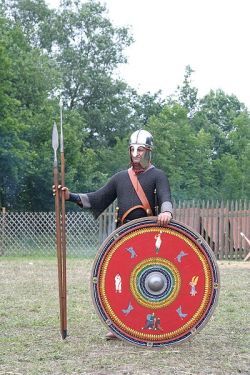Chapters
Battle of Argentoratum (357 CE) was a clash between the Roman troops led by Emperor Julian the Apostate with the Gauls who invaded the territory of the Empire.
Background of events
The northern frontier of the Roman Empire was a constant front in the fight against the invasions of Germanic peoples across the Rhine and Danube. A system of border fortifications known as limes successfully protected the Empire against the barbarians for a long time. However, along with the deepening crisis of the Roman state, the army (with the fame of the past) weakened as well. Legions still existed, but they were less numerous and less trained. The very structure of the army also changed – most of the “new legionaries” came from the local population, having Roman citizenship. During the glory of the Roman legions, the natives served in auxiliary units (auxilliares), but already in the 4th century CE. they were the backbone of the army. The importance of heavy driving, the so-called clibanarii.
A good example of a battle on the northern border of the Empire in the 4th century CE is the clash between the Romans and the Germans at Argentoratum (now Strasbourg) in the summer of 357 CE.
In the summer of 357 CE, Roman troops conducted a campaign in Galli, the purpose of which was to stop the plundering attacks by barbarians on the territory of the Empire. A few days before the battle, Emperor Julian the Apostate, commanding the Roman armies, received an embassy from the Alamanni, demanding that the emperor immediately cease combat operations and withdraw from the northern Galli. These demands were rejected and the envoys were taken captive, so as not to betray their superiors the state of Roman forces. Despite this procedure, the Alamans knew the position of the Roman troop’s thanks to one of the fugitives from Julian’s army. As a result, in front of the right-wing of Roman troops, consisting of heavy cavalry, there were Alamanni cavalry and light infantry, as units best suited to combat armoured cavalry. On their right-wing, the Alamans prepared an ambush against the Roman army from warriors hidden in the uneven terrain.
Military
The Roman army numbered about 13,000 soldiers in this battle. Its commander Julian the Apostate prepared his subordinates in two lines: in the first one stood a pseudo-legionary infantry, the so-called limitanei, recruited from the Germanic population. In fact, it was the militia, inhabitants of towns and villages, obliged to defend the borders of the Empire. In the second line stood several regular legions, consisting of the so-called pseudo- comitatenses, that is, soldiers of the field army serving as a reserve for the forces at the borders. The right-wing of Julian’s army was taken by heavy cavalry (clibanarii), assisted by horse archers. The left-wing of the Roman army was surrounded by forests and ditches, which made it impossible to outflank it.
Athe Alaman family numbered from 15,000 to 30,000 warriors. The leader of the Alamanni, Chnodomar, traditionally lined up his troops in one long line. As usual in the battles of the Romans with the Germans, he wanted to use the entirety of the troops to carry out a violent charge that would break through the enemy lines. The left wing of the Alaman formation, opposite the Roman cavalry, was occupied by the still awe-inspiring Germanic cavalry.
Battle
Before the Germanic warriors charged, both sides – the Alamans and the Teutons in the Roman army – let out the legendary Germanic war cry. The barbarian attack hit the first line of the Romans with force, the wing clashed with each other. Weak legionaries could not withstand such a violent attack and broke their ranks. The Alamans were also successful in the cavalry battle – the Roman cavalry commander was killed and the clibanarii retreated. The entire first Roman line was in retreat.
[ramka_ze_zdjejem img=”24825″ alt=”Battle of argentoratum” imgw=”600″ float=”center”]Battle of argentoratum[/ramka_ze_zdjeciem]
The rushing Germanic warriors attacked the second Roman line with force. Here, however, the more experienced comitatenses withstood the enemy’s onslaught. This allowed Julian to regroup his strained forces and throw them against Khnodomar’s troops. The Alamans lost their momentum and then began to be rebuked by the returning Romans. Eventually, the Alamans rushed to flee, pursued by a regrouped cavalry. Some of the escapees drowned trying to cross the Rhine. In total, the Alamans lost about 6,000 killed and about 200 prisoners, including King Khnodomar.
Consequences
The next day, the victorious Caesar ordered the Alamanic envoys to be released and to prepare for the crossing of the Rhine, which hastened the ceasefire between the Empire and the Alamans.
The Battle of Argentoratum is an example of the fact that both sides did not change their tactics despite the passage of time. The Germans, as always, stood in a long line and wanted to decide the fate of the battle with one charge. The Romans did not have such a well-trained army, so victory was difficult for them. It is also worth noting that driving was always neglected by the Romans. Over time, its importance grew more and more, to finally gain a key role on the battlefields in the next era.







